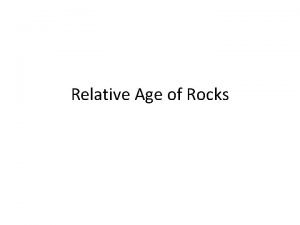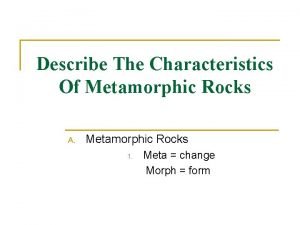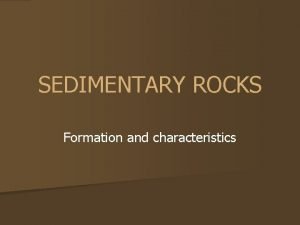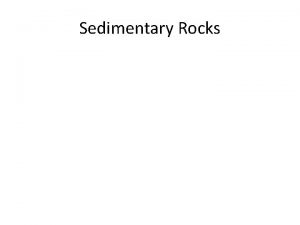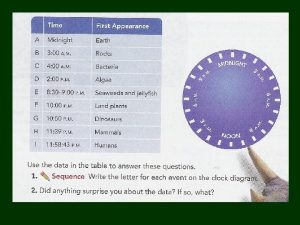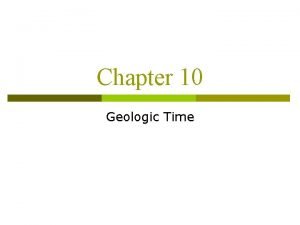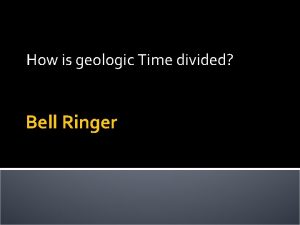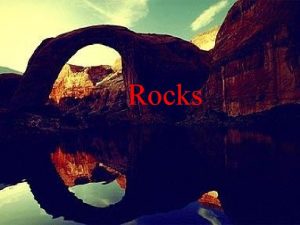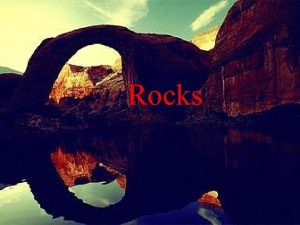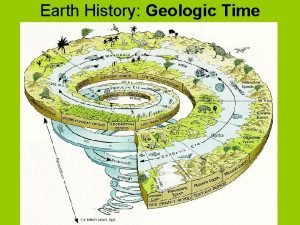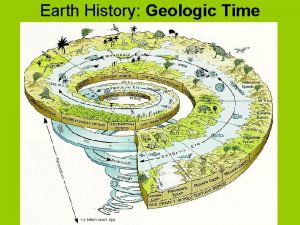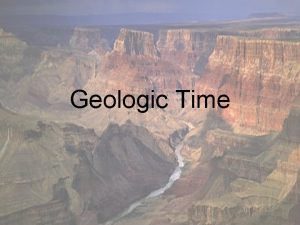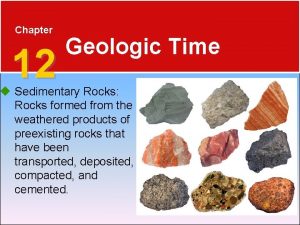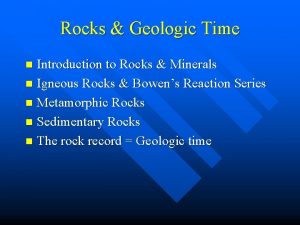GEOLOGIC MAPS Geologic Maps Shows geologic features rocks

















- Slides: 17

GEOLOGIC MAPS

Geologic Maps • Shows geologic features - rocks and faults. • Geology is represented by colors, lines, and special symbols unique to geologic maps.

Geologic Maps • • • Geologic maps are broken into a series of areas that are called – Geologic Units. A geologic unit is a kind of rock of a given age range. – A sandstone of one age might be colored bright orange, while a sandstone of a different age might be colored pale brown. Geologic units are named based on: 1. where the rock was first studied - the Briones sandstone first described in Briones Valley, California. 2. the kind of rock in the unit - 'Sandstone and shale, ' 'Unnamed sandstone', or 'Undivided shale' Geologic units are named by the geologists who made the geologic map Geologic units are represented by different colors.

Geologic Maps

Letter Symbols • Each geologic unit is assigned a combination of an initial Capital Letter followed by one or more small letters. – The capital letter represents the age of the geologic unit. Eons, Eras, Periods, and Epochs, based on the fossils found in rocks. • If the rock unit covers more than one time unit two capital letters are used. – QT would indicate that the rock unit began to form in Tertiary time and was completed in Quaternary time. • If the age is unknown, no capital letters are used. • Small letters define the name of the unit or the type of rock. – Kjm: Joaquin Miller sandstone formed in the Cretaceous Period – Ks: unnamed unit of shale formed in the Cretaceous Period – Gb: gabbro (a dark-colored igneous rock ) of unknown age.

Kjm Letter Symbols gb Ks

Lines on the Map Contact Lines • Contact: Place where two different geologic units are found next to each other, • Types of contacts: 1. Depositional Contacts 2. Faults 3. Folds 4. Solid, Dashed, or Dotted Lines 5. Strike and Dip

Lines on the Map Depositional Contact • The place where one type of rock rests on the rocks underneath. • Shown as a thin line.

Folds & Faults

Lines on the Map Faults • When different geologic units have been moved next to one another, the contact is a fault contact, • Shown by a thick line. • Faults can cut through a single geologic unit. These faults are shown with the same thick line on the map, but have the same geologic unit on both sides.

Lines on the Map Folds • Marked on a geologic map with a line a little thicker than a depositional contact, but thinner than a fault. • This line is referred to as a fold axis. • Fold Axis. A line that follows the crest or trough of the fold is called the fold axis.

Lines on the Map Other Lines • Solid Line: Places where the line is precisely located. • Dashed Line: Contacts that are uncertain due to soil, vegetation, or human construction. The shorter the dash, the more uncertain the location. • Dotted Line: Contacts that are covered by a geologic unit. • Modified Lines: Lines on a map may be modified using symbols on the line (triangles, small tic marks, arrows, and more). For example, faults with triangles can identify the type of fault.

Lines on the Map Dashed Line Dotted Line Modified Lines

Lines on the Map Strike and Dip • Shows tilted beds • Consists of 3 parts: long line, short line, and number. • Long Line: called the strike line, and shows the horizontal direction of the beds. • Short Line: called the dip line, and shows which way the bed is tilted. • Number: called the dip, shows the tilt of beds. The higher the number, the steeper the tilt, all the way up to 90 degrees if the bed is tilted all the way onto its side.

Map Key • The map key defines the colors and symbols. • Unit names and a short description of the kinds of rocks in that unit and their age are presented. • Different types of lines on the map are explained, and the different strike and dip symbols. • The map key will also include explanations of any other kinds of geologic symbols used on a map – – locations where fossils were found, locations of deposits of precious metals, location of faults known to be active, and geologic features specific to an area.

Map Key

THE END
 Igneous metamorphic and sedimentary
Igneous metamorphic and sedimentary Igneous vs metamorphic
Igneous vs metamorphic Compare geologic time with the geologic column.
Compare geologic time with the geologic column. Marli miller
Marli miller Granite diorite gabbro
Granite diorite gabbro How is intrusive igneous rock formed
How is intrusive igneous rock formed When god shows up he shows off
When god shows up he shows off Biochemical sedimentary rocks
Biochemical sedimentary rocks 5 characteristics of metamorphic rocks
5 characteristics of metamorphic rocks Sedimentary rocks characteristics
Sedimentary rocks characteristics Rocks formation
Rocks formation How are sedimentary rocks
How are sedimentary rocks Maps google maps reittihaku autolla
Maps google maps reittihaku autolla Geologic time
Geologic time Disconformity
Disconformity The longest subdivision of the geologic time scale is the
The longest subdivision of the geologic time scale is the What is the longest subdivision in geologic time
What is the longest subdivision in geologic time Moth scale
Moth scale



